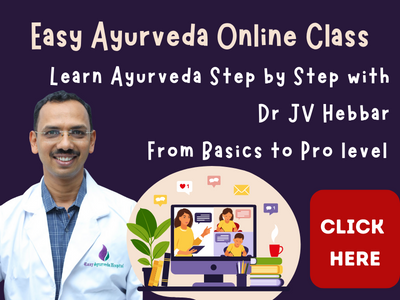Differences between Shodhana, Shamana and Brimhana Sneha
Article by Dr Raghuram Y.S. MD (Ay) & Dr Manasa S, B.A.M.S
Acharya Vagbhata has explained three types of Sneha i.e. Shodhana, Shamana and Brimhana Sneha depending on the purpose of why these unctuous substances have been used in each of the cases. The name of the Sneha itself will describe their purpose and action.
Shodhana Sneha – is used for the purpose of cleansing / purification of the body and is administered to expel severely aggravated doshas. It is used as a part of purvakarma i.e. preparatory procedure for Shodhana / Panchakarma therapies, mainly before administration of vamana or virechana. It consists of administering loading doses of Sneha in arohana krama i.e. increasing dose, every day, for a time period of three to seven days. The purpose is to saturate the body with medicated fat. The point of saturation shall be known by appearance of Samyak snigdha lakshanas i.e. signs of proper oleation / lubrication. Once this point is achieved, swedana – sudation should be given to liquify the doshas in the tissues and enable their flow towards the kostha – gut. Once the doshas reach the gut, they shall be expelled from the body by administering vamana or virechana, depending on the dosha being addressed.
Shamana Sneha – is used for the purpose of pacifying / palliating the moderately aggravated doshas. It is preferred in cases where shodhana is not required. The dose of Sneha shall be in small quantity. The medicine would be put into circulation wherein it would pacify the agitated doshas, wherever they are hyperactive.
Brimhana Sneha – is used for the purpose of enhancing bulk, mainly of the muscles, to increase weight in a healthy way and also to strengthen and fortify the body. This dose being small in quantity, will also pacify the mildly aggravated doshas. It can be administered to children and old aged persons too. It acts like a health tonic. It is also a food, apart from being a medicine and gets digested along with food before being put into circulation, since it is administered mixed with food.
After knowing about each of these three types of snehas in brief, let us try to know the differences between these three kinds of Sneha.
Differences between Shodhana, Shamana and Brimhana Sneha
| Feature | Shodhana Sneha | Shamana Sneha | Brimhana Sneha |
| Purpose | Shodhana – purification | Shamana – palliation | Brimhana – bulk promotion, enhancing weight, strengthening |
| Time of administration | Early morning | Morning (sometimes at other part of the day, as per need) | Any time – no specification |
| Relation to agni and food | When previously taken (previous night) food is digested properly On empty stomach When the person is not hungry i.e. when agni is not activated | On empty stomach Just before food When the patient is feeling hungry i.e. when agni is activated | Given mixed with / along with food |
| Duration | 3-7 days To be stopped after signs of proper oleation i.e. Samyak snigdha lakshanas are obtained | Used until the doshas are pacified | Can be variably used, until the purpose is met with |
| Arohana Krama – daily increase in dose | Yes – because the intention is to saturate the body | Not needed | Not needed |
| Relation to Panchakarma | Followed by Swedana, Vamana and / or Virechana | Not essential | Not essential |
| Relation to Doshas | Given for severely aggravated doshas | Given for moderately aggravated doshas | Need not have a doshic action, but being a medicine and food, it would pacify mildly aggravated doshas |
| Relation to Vyadhi | For very strong diseases | Diseases of moderate nature | Need not be related to diseases, but can pacify small disturbances or initial pathogenesis if any |
| Dose | Maximum (loading) dose – Uttama Matra – the quantity which gets digested in 24 hours (8 yama) | Moderate dose – Madhyama Matra – the quantity which gets digested in 12 hours (4 yamas) | Minimum dose – Hrsva Matra – the quantity which gets digested in 6 hours (2 yamas) |
Other areas of use of Brimhana Sneha (benefits)
Apart from causing brimhana, Brimhana Sneha is also used for the below mentioned purposes –
– In those accustomed to fatty foods (consume daily)
– Those who have fat-aversion
– In those who are addicted to wine (drink daily)
– Those who are indulged in sex, every day
– In those having mild increase of doshas
– In those having soft bowel movements
– In those who lead happy and comfortable life
– To those persons afraid of troubles and hardships
– In hot seasons
– In those having low digestion capacity (mandagni)
– In those having severe thirst
– In emaciated persons









